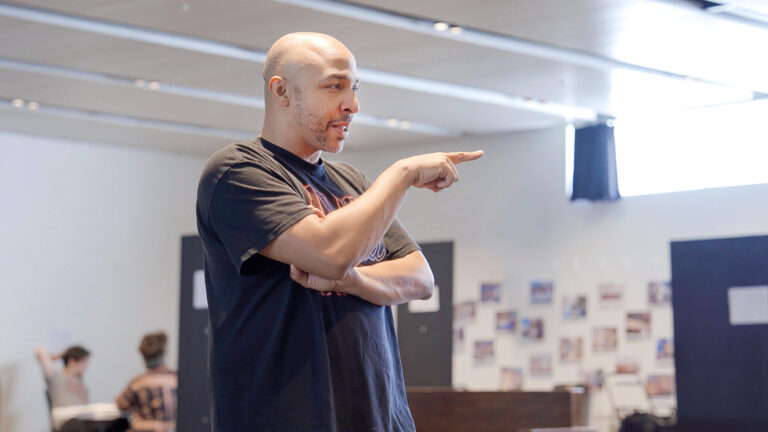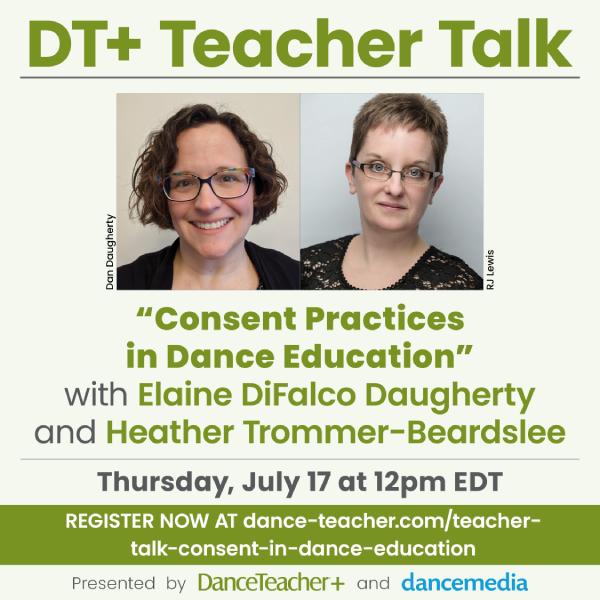Cynthia Lucas takes the Marin Ballet beyond 50.
Cynthia Lucas celebrates with Marin Ballet alumni, students and guest artists
Level-4 students in pre-pointe class
Level-9 dancers perform contemporary choreography by Casey Thorne
Just 15 miles north of foggy San Francisco, Marin Ballet’s studios are bathed in sunlight on a July morning, with a gentle breeze coming through open windows. Housed in a two-story building that was once a seminary, Marin Ballet is on a quiet street in San Rafael, California. The lobby, renovated last summer, feels airy and light with blond hardwood floors, white walls and a glass-lined stairway to the upper studios. On either side of the lobby, large windows offer views into spacious studios, with blinds that can be closed for privacy.
Upstairs, in a studio that once was the seminary’s chapel (a line of confessionals is hidden behind the studio mirrors), artistic director Cynthia Lucas teaches level-8 girls. The studio doubles as a 113-seat theater, and the arched ceiling now supports rigging for hanging lighting and wings. Older dancers (there are nine levels at the school) drape over foam rollers and physio balls on the seating risers, watching. Lucas is elegant in layers of black and teal and leggings that reveal calf muscles so sharply defined they look like they could cut granite. She is no-nonsense, focused on clarifying not just what she wants the students to do, but how they can approach doing it. She stops a frappé combination. “What is late?” she asks. One girl tentatively raises a hand. “I love the fact that you’re not scared,” says Lucas. The answer is the thighs. Lucas grabs her own thigh, joking that she has loose skin. When she demonstrates, she is lightning fast (and nothing wiggles).
Marin Ballet, which celebrated its 50th anniversary this year, has the longest history of the local schools. “We’re the organization that started dance in this area,” says executive director F. Lawrence Ewing. Marin Ballet, which has 325 students, is one of three ballet schools in the North Bay, with Marin Dance Theatre and Stapleton School of the Performing Arts. “This is a community that can support three schools,” explains Lucas.
Lucas is Marin Ballet’s first artistic director who also trained with MB founder Leona Norman. Norman started teaching ballet in nearby San Anselmo in 1950, renting space in an Arthur Murray Dance Studio. Three years later, Lucas, then age 3, started taking classes, begging her mother to let her try after watching her sister. “Leona said that I had somehow memorized things—shapes and positions—by watching,” says Lucas, who went on to a celebrated career as a first soloist, then principal ballet mistress with The National Ballet of Canada. Coming back 30 years later was coming home. “I’ve had an extraordinary full-circle experience,” she says.
Yet when she started as school director of Marin Ballet in 1998, the school was in transition. “I have a great respect for the foundation that Leona laid down for Marin Ballet,” she says. “But when I arrived, it was in a little bit of trouble. It had gone through a lot, and a lot of different directors. There was Margaret [Swarthout], then there was Mikko [Nissinen, now of Boston Ballet], then there was nobody at all.” When Swarthout left to found the newly formed Marin Dance Theatre in 1996, a number of the students and a faculty member from Marin Ballet followed her. “There was a lot of rebuilding to do,” says Lucas. “That has happened now. It’s strong.”
Marin Ballet has a niche: The school is open to all (no auditions), but the training is serious and requires students to be committed. “It’s this great middle ground,” says Ewing. “This is not recreational. If you want to be here, you can be here, but if you’re here, we’re going to ask you to work hard and diligently.”
Although the school provides the resources for pre-professional training, students are encouraged to determine their own paths. Some 2013 grads, for instance, headed this fall to the University of California, Berkeley—one on a math and computer science scholarship and another to study engineering—and to Princeton. “If they have the fortitude and the facility and, more than anything else, the mindset to become professional, we can take them there, and we have, time and time again,” says Ewing. Graduates have gone on to dance with San Francisco Ballet, Boston Ballet, Les Grands Ballets Canadiens de Montreal, Smuin Ballet, Robert Moses’ Kin and Sacramento Ballet. “But that’s not a requirement, or even our main goal,” he says. “Our goal is that kids learn about themselves, that they set their own goals that we help them achieve.”
This sense of agency is Lucas’ stamp on the school. Although she maintains a professional reserve, she encourages open communication. “I don’t believe in the idea of the teacher as guru,” says Lucas. “At Marin Ballet, the syllabus, the way I talk to my teachers and students, it’s all really about getting the children to own their work. It’s not just ballet, it’s lifelong lessons we’re teaching them.”
For instance, on this July day, Laurie Klein is teaching a level-3 class to a half-dozen 10- and 11-year-old girls, all in light blue leos and pink tights. It is the last day of the school’s summer session and a few parents wander in to watch. The students are on the floor, writing in journals. “How do you spell ‘pirouette’?” one asks, and Klein writes it on a blackboard hanging by the door. “They’ve been journaling each day,” she explains, “so that they can be conscious of what they’re trying to achieve this summer.” The journals are private: While Klein suggests topics, she doesn’t ask to see them.
When planning the school’s anniversary celebration, Lucas realized how similar her priorities were to the founder’s: “I didn’t even realize it until we went through the 50th and I went, ‘Wow, I’m doing exactly what she was.’” Preeminent is excellent classical training in the Vaganova tradition, with some of the Balanchine style, all with a spirit of artistic collaboration. “Leona brought the outside in and the inside out,” says Lucas. In addition to bringing in local choreographers, like Ronn Guidi (who went on to found Oakland Ballet Company), Norman herself traveled behind the Iron Curtain to visit the Vaganova school, beginning in the 1960s. “She watched Misha graduate,” says Lucas. “She went out and kept educating herself and brought it back.”
Lucas also cultivates talented teachers and choreographers. “Cindy has created an environment that’s very open to different artists,” says Sandra Jennings, a répétiteur with The George Balanchine Trust who has taught at the school and set Balanchine ballets on students since 2005. “She’s interested in the community—not only bringing us all in to be a part of it, but also giving her students an education that is very rich because we come from different backgrounds.” The school employs four full-time teachers, eight part-time teachers and seven accompanists, and it draws from a long list of guest teachers.
In addition to the school’s classical training, Lucas offers students what she calls “infusions” of contemporary, flamenco, West African and character. In the quieter mid-morning hours, when the studios are used by the Alonzo King LINES Ballet/Dominican University of California’s BFA program, Lucas pops in to watch classes, and three years ago she persuaded recent graduate Casey Lee Thorne to lead the contemporary program for the school.
Lucas chose critically acclaimed local choreographer Julia Adam to choreograph an elegant, whimsical new Nutcracker. Scenic artists and seamstresses from San Francisco Opera and Ballet created the sets and costumes. To manage the cost (about $350,000), Lucas spread the building of sets and costumes for the 175 dancers in the production over five years, and the choreography over three. The last piece, the party scene, was completed just in time for the school’s 50th-year celebration that began in December and continued into April, with a special concert featuring students and distinguished alumni. Lucas’ daughter, Mila Louise Lavoie, danced Ronn Guidi’s 1961 Trois Gymnopédies, which Lucas herself danced with Marin Ballet in 1967, and several advanced students performed Balanchine’s Raymonda Variations, set by Jennings.
The new Nutcracker and the renovation of the lobby were funded by a five-year, $1.3 million capital campaign. It is the first phase of a $10 million master plan, developed with an architect, to completely renovate the building, which the school purchased in 1972. “We’re working in phases,” says Ewing. “The roof and the studios are next.” Although the school is a nonprofit, most of its operating revenue (69 percent) comes from tuition; in 2012–2013, 14 percent of income was from donations (the rest was ticket revenues and facility rental). Lucas also dreams of building a midsized theater on their outdoor space.
“We’re so lucky here, it’s really something special,” says Lucas, who says she adores her job. “I’d love someone to find Miss Lucas at 93 in the studio, asleep in her chair. They’d just say, ‘I think she passed.’” Her eyes widen and she breaks into a huge grin. “That’d be a neat trick!” DT
San Francisco–based Caitlin Sims is former editor in chief of Dance Teacher.
Photos by (top to bottom): Lindsay Thomas, Olivier Wecxsteen, Rapt Productions, Olivier Wecxsteen; all images are courtesy of Marin Ballet




